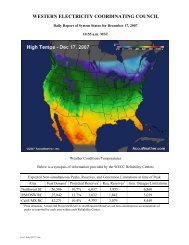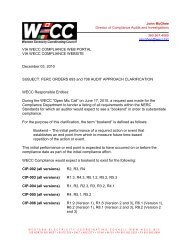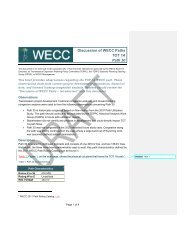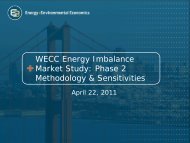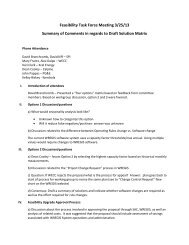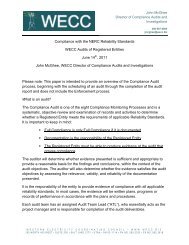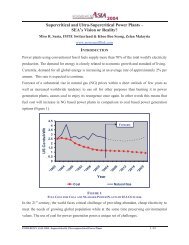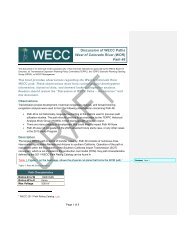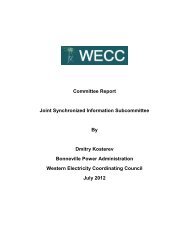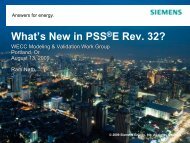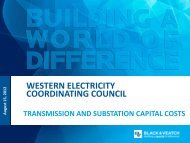Hurdle Rates
Hurdle Rates
Hurdle Rates
Create successful ePaper yourself
Turn your PDF publications into a flip-book with our unique Google optimized e-Paper software.
WECC Energy Imbalance<br />
Market: <strong>Hurdle</strong> Rate<br />
Development Lessons<br />
WECC MWG<br />
June 18, 2012<br />
Jack Moore, Sr. Consultant<br />
Arne Olson, Partner
Key Takeaways<br />
EIM Background: Why hurdle rates were so<br />
important for EIM analysis<br />
Impact: <strong>Hurdle</strong> rates can significantly affect flow<br />
across major interfaces<br />
Comparison: <strong>Hurdle</strong> rate vs. Wheeling rates in tariff<br />
<strong>Hurdle</strong> Rate process: Importance of first addressing<br />
other (non-transactional) factors that affect flows<br />
<strong>Hurdle</strong> Rate Level of detail : More precision may not<br />
mean more accuracy<br />
2
Context:<br />
EIM Project Goals and Approach<br />
Overall Goal:<br />
Estimate the societal benefits of implementing an EIM<br />
throughout the West (excluding CAISO and AESO)<br />
Approach:<br />
Societal Benefit<br />
of EIM =<br />
West-wide<br />
production cost<br />
without EIM -<br />
(Benchmark Case)<br />
West-wide<br />
production cost<br />
with EIM<br />
(EIM Case)<br />
Inter-BA transactions were a key driver of the<br />
benefits we were seeking to model<br />
Developed hurdle rate to apply Benchmark Case<br />
(GridView production simulation run)<br />
3
<strong>Hurdle</strong> <strong>Rates</strong> can impact regional<br />
flows on major interfaces<br />
“<strong>Hurdle</strong> <strong>Rates</strong>” are price adders, in<br />
$/MWh, that production simulation<br />
models use to inhibit trade between<br />
zones<br />
Can greatly affect flows over major<br />
interfaces depending on relative<br />
prices in adjacent zones<br />
• Depending on fuel & CO2 prices,<br />
coal vs. gas, local demand and heat<br />
rates, hurdle rates can make a big<br />
difference in relative cost<br />
Goal: want to represent<br />
institutional and issues that effect<br />
dispatch decisions & resulting<br />
regional transactions<br />
4
<strong>Hurdle</strong> <strong>Rates</strong> vs. Wheeling <strong>Rates</strong><br />
Many transactions don’t pay wheeling rates on a<br />
transaction basis because they own intertie transmission<br />
or have long-term service<br />
<strong>Hurdle</strong> rates should also capture other<br />
barriers to trade not reflected in<br />
wheeling rates<br />
• Pancaked losses<br />
• Inefficiencies due to illiquid markets<br />
• Need to use resources to serve native load<br />
Also is interactive: hurdle rates on one<br />
path can affect flows on other paths<br />
Approach: benchmarked simulation to<br />
actual 2006 path flows<br />
• Started with OATT rate schedules & losses, but then adjust as<br />
feasible to make simulation more similar to historical flows<br />
5
<strong>Hurdle</strong> rate development process:<br />
Benchmark everything else first<br />
1. Define zonal boundaries (for applying hurdles)<br />
2. Select monitored paths to monitor inter-zonal flows<br />
(must have historical data for comparison)<br />
3. Select historical benchmark year to simulate<br />
4. Remove as many (non-hurdle) differences as<br />
possible between historical data and benchmark<br />
simulation<br />
• Transmission, loads & generation, but also hydro levels,<br />
coal & nuclear maintenance schedules, etc.<br />
5. Start with wheeling rates, or other relevant initial set<br />
of hurdle rates<br />
6. Adjust iteratively until satisfied or no longer observing<br />
improvement<br />
6
Precision:<br />
Selecting right level of detail<br />
Possible in production simulation to benchmark with<br />
extremely precise level of detail<br />
• E.g., difference hurdle rates for HLH vs. LLH<br />
Challenge is that more precision may not capture<br />
barriers to trade more accurately, and entail more<br />
work for development<br />
• In extreme case, could specify every hour, but then would be<br />
capturing idiosyncratic issues, not more lasting institutional<br />
barriers & patterns<br />
• Even developing a single set of hurdle rate for the full year<br />
takes multiple iterations, so plan accordingly<br />
• Could deviate from the one hurdle rate for all hours on a<br />
particular path if have strong data & story that explains the<br />
dynamic<br />
7
Monitored Paths Used for<br />
Phase 1 and 2 <strong>Hurdle</strong> Rate Calibration<br />
(Shown with Phase 2 zone map)<br />
Zone<br />
Name<br />
Zone Description<br />
1 BC British Columbia<br />
2 AB Alberta<br />
3 BPA<br />
BPA + SCL + TWPR + GCPD<br />
+ CHPD + DOPD<br />
4 NWE Northwestern Energy + WAUW<br />
5 NNV<br />
Northern Nevada<br />
(Sierra Pacific Power)<br />
6 PACE PacifiCorp East<br />
7 WACM WAPA Rocky Mts.<br />
8 PSCO Xcel Colorado<br />
9 CA CAISO + CFE<br />
10 NEVP NV Energy<br />
11 AZPS APS<br />
12 NM New Mexico<br />
13 PSE Puget Sound Energy<br />
14 AVA Avista<br />
15 PGN Portland General Electric<br />
16 PACW PacifiCorp West<br />
17 IPC Idaho Power<br />
18 WALC WAPA Lower Colorado<br />
19 SRP Salt River Project<br />
20 TEP Tucson Electric Power<br />
21 BANC BA of N. CA+ Turlock ID<br />
22 EPE El Paso Electric<br />
23 LADWP LA Dept. of Water & Power<br />
24 IID Imperial Irrigation District<br />
Zone 1 Zone 2<br />
Northwest-BC (P3)<br />
COI<br />
(P66)<br />
ID-Northwest<br />
(P14)<br />
Path C<br />
(P20)<br />
PDCI<br />
(P65)<br />
West of<br />
River (P46)<br />
MT-Northwest (P8)<br />
MT-ID<br />
(P18)<br />
IPPDC<br />
(P27) Tot 2B<br />
Tot 2C (P34) Tot 2A<br />
(P35)<br />
(P31)<br />
EOR<br />
(P49)<br />
Bridger We<br />
(P19)<br />
Tot 3<br />
(P36)<br />
No. NM<br />
(P48)<br />
So. NM<br />
(P47)<br />
8
Incremental Improvement in<br />
Simulating Historical 2006 Flows<br />
Results of sequential runs<br />
shows incremental<br />
improvement in historical<br />
year simulation<br />
• Overall average flows now 0.1%<br />
below historical<br />
• Small reductions to absolute<br />
value of difference in simulated<br />
vs. actual flows<br />
Accuracy varies by path<br />
• Accuracy is very good for Westside<br />
paths<br />
• East side flows still higher than<br />
historical, despite large hurdle<br />
rates<br />
• Non-economic factors in model<br />
likely limit greater precision<br />
% Difference from Actual Average Hourly<br />
Flow over 17 WECC Paths (MW)<br />
Avg Hourly Flow<br />
vs. Actual (% Difference)<br />
15%<br />
12%<br />
9%<br />
6%<br />
3%<br />
0%<br />
-3%<br />
-6%<br />
Absolute Value of Hourly Difference in Flow<br />
Average over 17 WECC Paths (MW)<br />
Avg Abs Value of Flow<br />
vs. Actual (MW)<br />
550<br />
500<br />
450<br />
400<br />
350<br />
300<br />
0.1%<br />
below<br />
actual<br />
9
Benchmarking Simulation versus<br />
2006 Actual Hourly Flows<br />
2006 Actual Flows Phase 2 Simulation Flows<br />
Path Flows (MW)<br />
3,000<br />
2,000<br />
1,000<br />
0<br />
-1,000<br />
-2,000<br />
-3,000<br />
P3: NORTHWEST-BC (S-N)<br />
Jan<br />
Feb<br />
Mar<br />
Apr<br />
May<br />
Jun<br />
Jul<br />
Aug<br />
Sep<br />
Oct<br />
Nov<br />
Dec<br />
Path Flows (MW)<br />
P8: MONTANA-NORTHWEST (E-W)<br />
3,000<br />
2,000<br />
1,000<br />
0<br />
-1,000<br />
-2,000<br />
Jan<br />
Feb<br />
Mar<br />
Apr<br />
May<br />
Jun<br />
Jul<br />
Aug<br />
Sep<br />
Oct<br />
Nov<br />
Dec<br />
Path Flows (MW)<br />
2,500<br />
2,000<br />
1,500<br />
1,000<br />
500<br />
0<br />
P19: BRIDGER WEST (E-W)<br />
Jan<br />
Feb<br />
Mar<br />
Apr<br />
May<br />
Jun<br />
Jul<br />
Aug<br />
Sep<br />
Oct<br />
Nov<br />
Dec<br />
Path Flows (MW)<br />
10,000<br />
8,000<br />
6,000<br />
4,000<br />
2,000<br />
-2,000 0<br />
-4,000<br />
P65+P66: COI & PDCI (N-S)<br />
Jan<br />
Feb<br />
Mar<br />
Apr<br />
May<br />
Jun<br />
Jul<br />
Aug<br />
Sep<br />
Oct<br />
Nov<br />
Dec<br />
Path Flows (MW)<br />
P14: IDAHO-NORTHWEST (E-W)<br />
3,000<br />
2,000<br />
1,000<br />
0<br />
-1,000<br />
-2,000<br />
Jan<br />
Feb<br />
Mar<br />
Apr<br />
May<br />
Jun<br />
Jul<br />
Aug<br />
Sep<br />
Oct<br />
Nov<br />
Dec<br />
Path Flows (MW)<br />
2,000<br />
1,500<br />
1,000<br />
500<br />
0<br />
P36: TOT 3 (N-S)<br />
Jan<br />
Feb<br />
Mar<br />
Apr<br />
May<br />
Jun<br />
Jul<br />
Aug<br />
Sep<br />
Oct<br />
Nov<br />
Dec<br />
Path Flows (MW)<br />
P46:WEST OF RIVER (WOR) (E-W)<br />
10,000<br />
8,000<br />
6,000<br />
4,000<br />
2,000<br />
0<br />
Jan<br />
Feb<br />
Mar<br />
Apr<br />
May<br />
Jun<br />
Jul<br />
Aug<br />
Sep<br />
Oct<br />
Nov<br />
Dec<br />
Path Flows (MW)<br />
1,000<br />
500<br />
0<br />
-500<br />
-1,000<br />
P34: TOT 2B (N-S)<br />
Jan<br />
Feb<br />
Mar<br />
Apr<br />
May<br />
Jun<br />
Jul<br />
Aug<br />
Sep<br />
Oct<br />
Nov<br />
Dec<br />
Path Flows (MW)<br />
1,000<br />
500<br />
0<br />
-500<br />
-1,000<br />
P31: TOT 2A (N-S)<br />
Jan<br />
Feb<br />
Mar<br />
Apr<br />
May<br />
Jun<br />
Jul<br />
Aug<br />
Sep<br />
Oct<br />
Nov<br />
Dec<br />
(Path flow primary direction in parenthesis)<br />
10
Seasonal Benchmarking:<br />
Average Path Transfers during HLH<br />
11<br />
2006 Historical Flows Phase 2 Simulation Phase 1 Simulation<br />
Path Flows (MW)<br />
2,000<br />
P3: NORTHWEST-BC (S-N)<br />
1,500<br />
1,000<br />
500<br />
0<br />
-500<br />
Winter Spring Summer Fall<br />
Path Flows (MW)<br />
P8: MONTANA-NORTHWEST (E-W)<br />
2,000<br />
1,500<br />
1,000<br />
500<br />
0<br />
Winter Spring Summer Fall<br />
Path Flows (MW)<br />
2,000<br />
P19: BRIDGER WEST (E-W)<br />
1,500<br />
1,000<br />
500<br />
0<br />
Winter Spring Summer Fall<br />
Path Flows (MW)<br />
6,000<br />
5,000<br />
4,000<br />
3,000<br />
2,000<br />
1,000<br />
0<br />
P65+P66: COI & PDCI (N-S)<br />
Winter Spring Summer Fall<br />
Path Flows (MW)<br />
P14: IDAHO-NORTHWEST (E-W)<br />
1,400<br />
1,200<br />
1,000<br />
800<br />
600<br />
400<br />
200<br />
0<br />
Winter Spring Summer Fall<br />
Path Flows (MW)<br />
1,200<br />
1,000<br />
800<br />
600<br />
400<br />
200<br />
0<br />
P36: TOT 3 (N-S)<br />
Winter Spring Summer Fall<br />
Path Flows (MW)<br />
P46:WEST OF RIVER (WOR) (E-W)<br />
7,000<br />
6,000<br />
5,000<br />
4,000<br />
3,000<br />
2,000<br />
1,000<br />
0<br />
Winter Spring Summer Fall<br />
Path Flows (MW)<br />
400<br />
300<br />
200<br />
100<br />
0<br />
-100<br />
-200<br />
P34: TOT 2B (N-S)<br />
Winter Spring Summer Fall<br />
Path Flows (MW)<br />
600<br />
500<br />
400<br />
300<br />
200<br />
100<br />
0<br />
P31: TOT 2A (N-S)<br />
Winter Spring Summer Fall
Seasonal Benchmarking:<br />
Average Path Transfers during LLH<br />
12<br />
2006 Historical Flows Phase 2 Simulation Phase 1 Simulation<br />
Path Flows (MW)<br />
1,500<br />
P3: NORTHWEST-BC (S-N)<br />
1,000<br />
500<br />
0<br />
-500<br />
Winter Spring Summer Fall<br />
Path Flows (MW)<br />
P8: MONTANA-NORTHWEST (E-W)<br />
2,000<br />
1,500<br />
1,000<br />
500<br />
0<br />
Winter Spring Summer Fall<br />
Path Flows (MW)<br />
2,500<br />
P19: BRIDGER WEST (E-W)<br />
2,000<br />
1,500<br />
1,000<br />
500<br />
0<br />
Winter Spring Summer Fall<br />
Path Flows (MW)<br />
6,000<br />
5,000<br />
4,000<br />
3,000<br />
2,000<br />
1,000<br />
0<br />
P65+P66: COI & PDCI (N-S)<br />
Winter Spring Summer Fall<br />
Path Flows (MW)<br />
P14: IDAHO-NORTHWEST (E-W)<br />
1,400<br />
1,200<br />
1,000<br />
800<br />
600<br />
400<br />
200<br />
0<br />
Winter Spring Summer Fall<br />
Path Flows (MW)<br />
1,200<br />
1,000<br />
800<br />
600<br />
400<br />
200<br />
0<br />
P36: TOT 3 (N-S)<br />
Winter Spring Summer Fall<br />
Path Flows (MW)<br />
P46:WEST OF RIVER (WOR) (E-W)<br />
7,000<br />
6,000<br />
5,000<br />
4,000<br />
3,000<br />
2,000<br />
1,000<br />
0<br />
Winter Spring Summer Fall<br />
Path Flows (MW)<br />
500<br />
400<br />
300<br />
200<br />
100<br />
0<br />
-100<br />
-200<br />
P34: TOT 2B (N-S)<br />
Winter Spring Summer Fall<br />
Path Flows (MW)<br />
700<br />
600<br />
500<br />
400<br />
300<br />
200<br />
100<br />
0<br />
P31: TOT 2A (N-S)<br />
Winter Spring Summer Fall
Thank You!<br />
Energy and Environmental Economics, Inc. (E3)<br />
101 Montgomery Street, Suite 1600<br />
San Francisco, CA 94104<br />
Tel 415-391-5100<br />
Web http://www.ethree.com<br />
Arne Olson, Partner (arne@ethree.com)<br />
Jack Moore, Sr. Consultant (jack@ethree.com)
Appendix
<strong>Hurdle</strong> <strong>Rates</strong> Used for<br />
Phase 2 Study<br />
Benchmark Case <strong>Hurdle</strong><br />
<strong>Rates</strong> (2010 $/MWh)<br />
Difference from<br />
Tariff Rate + Losses<br />
From To Forward Backward Forward Backward<br />
AB BC $4.72 $3.63 ($5.98)<br />
BPA BC $3.26 $3.63 ($5.98)<br />
NWE BPA $14.72 $3.26 $7.50<br />
IPC BPA $11.36 $3.26 $7.50<br />
BPA NNV $6.44 $6.04<br />
BPA CA $11.44 $7.29 $5.00<br />
NWE WACM $12.22 $7.27 $5.00<br />
PACE NNV $5.06 $6.04<br />
PACE WACM $10.06 $7.27 $5.00<br />
WACM PSCO $14.77 $4.22 $7.50<br />
NNV CA $6.04 $3.88<br />
PACE AZPS $12.56 $3.62 $7.50 ($1.00)<br />
PACE LADWP $40.00 $9.68 $34.94<br />
WACM WALC $14.77 $3.64 $7.50<br />
NNV NEVP $6.04 $3.03<br />
NEVP CA $8.03 $3.88 $5.00<br />
PACE NEVP $12.56 $2.03 $7.50 ($1.00)<br />
NEVP WALC $3.03 $3.64<br />
AZPS CA $9.62 $3.88 $5.00<br />
AZPS NM $2.12 $5.43 ($2.50)<br />
PSCO NM $9.22 $5.43 $5.00<br />
NM WALC $5.43 $3.64<br />
Benchmark Case <strong>Hurdle</strong><br />
<strong>Rates</strong> (2010 $/MWh)<br />
Note: In EIM Case, hurdle rates shown in blue text above are applied during unit commitment but set to zero during<br />
dispatch. <strong>Rates</strong> in gold text (related to a zone not participating in the EIM) are maintained during both unit<br />
commitment and dispatch.<br />
Difference from<br />
Tariff Rate + Losses<br />
From To Forward Backward Forward Backward<br />
AVA BC $4.07 $3.63 ($5.98)<br />
AVA BPA $4.07 $3.26<br />
IPC AVA $11.36 $4.07 $7.50<br />
NWE AVA $14.72 $4.07 $7.50<br />
AVA PACW $4.07 $5.06<br />
BPA LADWP $8.94 $9.68 $2.50<br />
WACM NM $14.77 $5.43 $7.50<br />
PACE WALC $12.56 $2.64 $7.50 ($1.00)<br />
PACE IPC $5.06 $3.86<br />
PSCO WALC $11.72 $3.64 $7.50<br />
WALC CA $8.64 $3.88 $5.00<br />
PACW CA $10.06 $3.88 $5.00<br />
PACE CA $40.00 $9.68 $34.94<br />
IID CA $4.13 $3.88<br />
LADWP CA $9.68 $3.88<br />
CA BANC $3.88 $5.99<br />
AZPS IID $2.12 $4.13 ($2.50)<br />
AZPS LADWP $9.62 $9.68 $5.00<br />
AZPS SRP $2.12 $2.98 ($2.50)<br />
AZPS TEP $2.12 $4.88 ($2.50)<br />
AZPS WALC $2.12 $3.64 ($2.50)<br />
15
<strong>Hurdle</strong> <strong>Rates</strong> Used for<br />
Phase 2 Study (continued)<br />
Additional <strong>Hurdle</strong> <strong>Rates</strong><br />
(continued from previous slide)<br />
Benchmark Case <strong>Hurdle</strong><br />
<strong>Rates</strong> (2010 $/MWh)<br />
Difference from<br />
Tariff Rate + Losses<br />
From To Forward Backward Forward Backward<br />
BPA PACW $3.26 $5.06<br />
BPA PGN $3.26 $1.62<br />
BPA PSE $3.26 $0.96<br />
BPA BANC $8.94 $5.99 $2.50<br />
NM EPE $5.43 $5.63<br />
TEP EPE $4.88 $5.63<br />
IPC NNV $11.36 $6.04 $7.50<br />
IPC PACW $11.36 $5.06 $7.50<br />
IPC PGN $11.36 $1.62 $7.50<br />
NEVP LADWP $8.03 $9.68 $5.00<br />
NNV LADWP $40.00 $9.68 $33.96<br />
NWE PACE $14.72 $5.06 $7.50<br />
PACW PGN $5.06 $1.62<br />
AVA PGN $4.07 $1.62<br />
TEP NM $2.38 $5.43 ($2.50)<br />
SRP CA $7.98 $3.88 $5.00<br />
SRP TEP $2.98 $4.88<br />
SRP WALC $2.98 $3.64<br />
WALC TEP $3.64 $4.88<br />
WALC IID $3.64 $4.13<br />
WALC LADWP $8.64 $9.68 $5.00<br />
Note: In EIM Case, hurdle rates shown in blue text above are<br />
applied during unit commitment but set to zero during dispatch.<br />
Phase 2 calibrated bidirectional<br />
hurdle rates for 64 different<br />
interfaces (vs. 25 in Phase 1)<br />
For new interfaces for<br />
Phase 2 (esp. in NW and AZ)<br />
stayed close to OATT tariff rates<br />
unless flow results available to<br />
indicate otherwise<br />
In calibration, added $2-8<br />
premium to tariff rates to<br />
reduce certain flows:<br />
• N-S flows on East side<br />
• MT/ID into NW<br />
• CA imports<br />
• For PACE->CA, used large hurdle<br />
rate to make flows resemble 2006<br />
actual when IPP gen is offline<br />
16
Creation of 2006 Benchmark Case<br />
WECC 2020 PC0 case rolled back to 2006 by removing<br />
major generation and transmission to create a 2006<br />
system topology<br />
• System changes made by WECC staff<br />
• Not possible to precisely reconfigure PROMOD database back to<br />
2006 – may be small inaccuracies where upgrades are complex<br />
(e.g., north of Salt Lake City)<br />
Incorporated historical data from WECC and NREL: Fuel<br />
prices, hydro availability, hourly wind & load profiles<br />
Modified reserve requirements<br />
Created 24 zones by assigning busses to a zone and<br />
grouping lines that interconnect zones<br />
Implemented hurdle rates that affect transactions<br />
between zones & adjusted until major path flows and<br />
gen dispatch match 2006 actual<br />
17
Phase 2 Results<br />
$141MM in annual<br />
savings from EIM for<br />
2020<br />
• 0.7% reduction in<br />
total production costs<br />
• Ranges from $54-233MM<br />
among all cases run<br />
Lower overall savings<br />
compared to Phase 1<br />
• Phase 1 assumed more<br />
optimization of operations<br />
Millions of 2010$<br />
150<br />
100<br />
50<br />
0<br />
Phase 2 EIM Benefits<br />
(MM 2010 Dollars)<br />
$50MM<br />
$141MM<br />
2006 EIM 2020 EIM<br />
18



